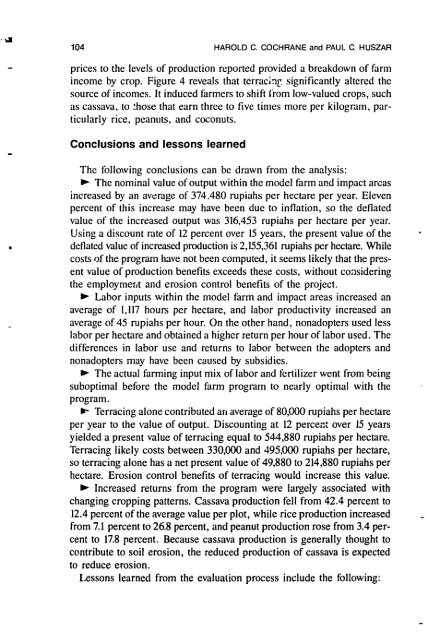Conservation farming on steep lands - USAid
Conservation farming on steep lands - USAid
Conservation farming on steep lands - USAid
You also want an ePaper? Increase the reach of your titles
YUMPU automatically turns print PDFs into web optimized ePapers that Google loves.
104 HAROLD C. COCHRANE and PAUL C. HUSZAR<br />
prices to the levels of producti<strong>on</strong> reported provided a breakdown of farm<br />
income by crop. Figure 4 reveals that terraci~g significantly altered the<br />
source of incomes. It induced farmers to shift from low-valued crops, such<br />
as cassava, to :hose that earn three to five times more per kilogram, particularly<br />
rice, peanuts, and coc<strong>on</strong>uts.<br />
C<strong>on</strong>clusi<strong>on</strong>s and less<strong>on</strong>s learned<br />
The following c<strong>on</strong>clusi<strong>on</strong>s can be drawn from the analysis:<br />
The nominal value of output within the model farm and impact arcas<br />
increased by an average of 374,480 rupiahs per hectare per year. Eleven<br />
percent of this increase may have been due to inflati<strong>on</strong>, so the deflated<br />
value of the increased output was 316,453 rupiahs per hectare per year.<br />
Using a discount rate of 12 percent over 15 years, the present value of the<br />
deflated value of increased producti<strong>on</strong> is 2,155,361 rupiahs per hectare. While<br />
costs of the program have not been computed, it seems likely that the przsent<br />
value of producti<strong>on</strong> benefits exceeds these costs, without coasidering<br />
the employmer~t and erosi<strong>on</strong> c<strong>on</strong>trol benefits of the project.<br />
Labor inputs within the model farm and impact areas increased an<br />
average of 1,117 hours per hectare, and labor productivity increased an<br />
average of 45 rupiahs per hour. On the other hand, n<strong>on</strong>adopters used less<br />
labor per hectare and obtained a higher return per hour of labor used. The<br />
differences in labor use and returns to labor between the adopters and<br />
n<strong>on</strong>adopters may have been caused by subsidies.<br />
b The actual <str<strong>on</strong>g>farming</str<strong>on</strong>g> input mix of labor and fertilizer went from being<br />
suboptimal before the model farm program to nearly optimal with the<br />
program.<br />
B- Terracing al<strong>on</strong>e c<strong>on</strong>tributed arr average of 80,000 rupiahs per hectare<br />
per year to the value of output. Discounting at 12 percent over 15 years<br />
yielded a present value of terracing equal to 544,880 rupiahs per hectare.<br />
Terracing likely costs between 330,000 and 495,000 rupiahs per hectare,<br />
so terracing al<strong>on</strong>e has a net present value of 49,880 to 214,880 rupiahs per<br />
hectare. Erosi<strong>on</strong> c<strong>on</strong>trol benefits of terracing would increase this value.<br />
Increased returns from the program were largely associated with<br />
changing cropping patterns. Cassava producti<strong>on</strong> fell from 42.4 percent to<br />
12.4 percent of the average value per plot, while rice producti<strong>on</strong> increased -<br />
from 7.1 percent to 26.8 percent, and peanut producti<strong>on</strong> rose from 3.4 percent<br />
to 17.8 percent. Because cassava producti<strong>on</strong> is generally thought to<br />
c<strong>on</strong>tribute to soil erosi<strong>on</strong>, the reduced producti<strong>on</strong> of cassava is expected<br />
to reduce erosi<strong>on</strong>.<br />
Less<strong>on</strong>s learned from the evaluati<strong>on</strong> process include the following:
















